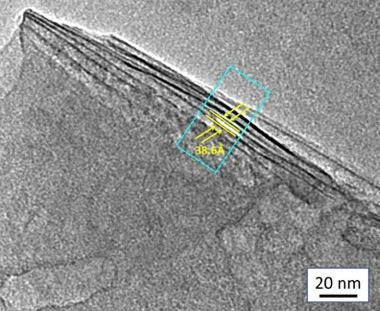Mar 13 2020
Ten years ago, researchers at Drexel University had created the first-ever sample of a group of nanomaterials, known as MXenes. Today, these materials are being extensively studied.
 Drexel University researchers have developed a way to produce the promising 2D nanomaterials, MXenes, without using water. This allows the materials to be used for applications like energy storage and solar cells, where the presence of water could degrade performance. Image Credit: Drexel University.
Drexel University researchers have developed a way to produce the promising 2D nanomaterials, MXenes, without using water. This allows the materials to be used for applications like energy storage and solar cells, where the presence of water could degrade performance. Image Credit: Drexel University.
Now, the scientists have identified another method to produce the atom-thin material that offers several new opportunities for applying it. The latest discovery eliminates water from the process used for making MXenes. This implies that the materials can be utilized in applications, like next-generation solar cells and battery electrodes, where water impedes performance or acts as a contaminant.
This finding provides a new kind of recipe for the chemical etching solution that produces MXene by carving away layers from a ceramic precursor material, known as the MAX phase. MXenes are two-dimensional (2D) layered materials. The results of the study were recently reported in the Chem journal.
Water has been used in the MXene-making processes to dilute the etching acid and as a solvent to neutralize the reaction, but it is not always desirable to have traces of it in the finished product. We have been working for some time to explore other etchants for the MAX P-phase and now we have found just the right combination of chemicals to do it.
Michel Barsoum, PhD, Distinguished Professor, College of Engineering, Drexel University
Lately, MXenes have attracted a great deal of interest as a conductive, long-lasting, and multipurpose material that may one day enhance telecommunications, facilitate functional textiles, and enhance energy storage technology.
To produce these materials, a concentrated acid is generally used to cut away atomic layers from a MAX phase material, which are subsequently washed with water, leaving behind flakes of the 2D-layered material. These flakes can then be pressed into thin films for battery electrodes and microchips, or utilized to coat devices to prevent electromagnetic interference or spray-paint antennas.
Barsoum and his collaborators reported a process in which ammonium dihydrogen fluoride—a chemical that is often employed to etch glass—and an organic solvent are used to etch the MAX phase. The solution partially performs the etching process since it decomposes into hydrofluoric acid. It does not need water to remove the by-products of the etching process or to dilute it.
This process of producing MXene materials changes their internal chemical structure in a way that renders them more suitable for use in certain types of solar cells and batteries—where water is likely to slow down the chemical reactions that store and/or change energy, or in a few instances, even lead to corrosion.
MXenes have shown tremendous potential for improving energy storage devices, but this discovery makes them even more promising. It is known that even slight presence of water in lithium or sodium-ion batteries using organic electrolytes, can be detrimental to their performance.
Varun Natu, Study First Author and Doctoral Researcher, College of Engineering, Drexel University
Natu continued, “In this work we show that MXene films synthesized in propylene carbonate—when tested as anodes in a sodium-ion battery—exhibit nearly double the capacity of the same composition etched in water. In addition, MXenes can now easily be integrated with materials which degrade in water, like certain polymers, quantum dots and perovskites.”
Apart from improving the MXene material for such applications—with other applications yet to be analyzed—the novel process makes it possible to recover and reuse the etching solution. This may prove to be useful as companies and scientists investigate the most efficient method to upgrade the manufacturing process.
Scientists, who took part in this study, including Vibha Kalra, PhD, an associate professor in the College of Engineering, have been looking for ways to enhance the safety and performance of batteries by creating new kinds of electrodes. This finding could introduce novel options in these efforts and also advance the area of MXene research at Drexel University.
This finding opens up a huge new field of research: Non-aqueous etching of MXenes. We believe that this work will prove useful not only to the MXene community, but also to researchers throughout the field of material science.
Michel Barsoum, PhD, Distinguished Professor, College of Engineering, Drexel University